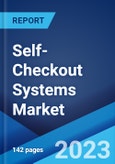Self-checkout systems refer to mechanical and technological solutions that enable shoppers to scan, bag and pay for their purchases without human assistance in retail outlets. They allow the customer to process their purchases by themselves without requiring support from a cashier. The system consists of a touch-screen panel, barcode scanner to scan and record the codes of the products, basket stand, weighing scale and cash and card payment module. It offers various benefits, such as reduced waiting time for the customers and instances of cart abandonment, optimal utilization of resources and enhanced operational flexibility.
Rapid urbanization, along with increasing automation in the retail sector, is one of the key factors driving the growth of the market. Furthermore, the emerging trend of unmanned store concepts, especially in developing countries, is stimulating the market growth. In line with this, there is a shift in the consumer preference for touch-free transactions across the entertainment sector, such as in casinos, museums, movie theaters, sports arenas and theme parks, which is creating a positive outlook for the market.
Moreover, self-checkout systems offer enhanced security features, intuitive consumer interfaces, cashless transaction facilities and multi-item scanning facilities, thereby increasing their demand across convenience/departmental stores, hypermarkets, and supermarkets. Additionally, various technological advancements, such as the integration of radio frequency identification (RFID) and near-field communication (NFC) systems in self-checkout machines, are acting as other growth-inducing factors.
RFID readers can automatically read labels on the products and add them to the cart to proceed with the purchase. Other factors, including the increasing demand for a personalized and assisted shopping experience, along with the utilization of artificial intelligence (AI) and machine learning-based systems, are anticipated to drive the market further.
Key Market Segmentation:
The publisher provides an analysis of the key trends in each sub-segment of the global self-checkout systems market report, along with forecasts at the global, regional and country level from 2024-2032. Our report has categorized the market based on offering, model type, mounting type and end user.Breakup by Offering:
- Hardware
- Software
- Services
Breakup by Model Type:
- Cash Model Type
- Cashless Model Type
Breakup by Mounting Type:
- Stand-Alone Mounting
- Wall-Mounted and Countertop Mounting
Breakup by End User:
- Supermarkets and Hypermarkets
- Departmental Stores
- Convenience Stores
- Others
Breakup by Region:
- North America
- United States
- Canada
- Asia Pacific
- China
- Japan
- India
- South Korea
- Australia
- Indonesia
- Others
- Europe
- Germany
- France
- United Kingdom
- Italy
- Spain
- Russia
- Others
- Latin America
- Brazil
- Mexico
- Others
- Middle East and Africa
Competitive Landscape:
The competitive landscape of the industry has also been examined with some of the key players being Diebold Nixdorf Inc., Digimarc Corporation, ECR Software Corporation, Fujitsu Limited (Furukawa Group), IBM Corporation, ITAB Scanflow AB, NCR Corporation, Pan-Oston Co., PCMS Group Inc., and Toshiba TEC Corporation.Key Questions Answered in This Report
1. What was the size of the global self-checkout systems market in 2023?2. What is the expected growth rate of the global self-checkout systems market during 2024-2032?
3. What has been the impact of COVID-19 on the global self-checkout systems market?
4. What are the key factors driving the global self-checkout systems market?
5. What is the breakup of the global self-checkout systems market based on the model type?
6. What is the breakup of the global self-checkout systems market based on the mounting type?
7. What is the breakup of the global self-checkout systems market based on the end user?
8. What are the key regions in the global self-checkout systems market?
9. Who are the key players/companies in the global self-checkout systems market?
Table of Contents
Companies Mentioned
- Diebold Nixdorf Inc.
- Digimarc Corporation
- ECR Software Corporation
- Fujitsu Limited (Furukawa Group)
- IBM Corporation
- ITAB Scanflow AB
- NCR Corporation
- Pan-Oston Co. PCMS Group Inc.
- Toshiba TEC Corporation
Methodology

LOADING...
Table Information
| Report Attribute | Details |
|---|---|
| No. of Pages | 146 |
| Published | August 2024 |
| Forecast Period | 2023 - 2032 |
| Estimated Market Value ( USD | $ 5 Billion |
| Forecasted Market Value ( USD | $ 13.4 Billion |
| Compound Annual Growth Rate | 11.6% |
| Regions Covered | Global |
| No. of Companies Mentioned | 9 |









